Steven Romick at the FPA Crescent fund is one of the top value managers in the mutual fund space. The fund has served its shareholders very well by delivering superior returns of 11% CAGR over the last decade with lower risk relative to most other mutual funds.
In addition, FPA Crescent is well known for its shareholder communication. They regularly conduct conference calls to update the fund shareholders on FPA’s view of the world and on the fund’s portfolio activity. These calls have been a rich source of new ideas for me. I first learnt about Ensco through comments made on a call they held post the BP oil spill. The investment has done very well since then.
Two quarters ago, I learnt about CVS Caremark through some comments made by one of their analysts on the call. CVS statistically seemed very cheap then, but I was not very familiar with its business. At the same time, Sequoia fund had exited out of Walgreens because of their lack of confidence in Walgreens’ ability to maintain margins going forward. In order to understand the source of the pharmaceutical drug margins for the suppliers, I spent a good amount of time reading industry reports as well as reading CVS’ and its competitors’ 10-Ks and conference call transcripts. I wrote down everything I learnt into a report. The report turned out to be 40 pages long. Obviously, not everything was relevant to the investment thesis for CVS. But, it was a good way for me to expand my circle of competence into a new industry. Later, I took the report and submitted it as-is for the April Value Contest. I didn’t realize that Gurufocus readers have limited time and only want the relevant information (including me when I am reading other people’s articles). The article got low ratings and probably deservedly so.
However, I urge the reader not to pass on CVS Caremark simply because of the poor quality of my writing. Luckily we a solution on hand to avert this situation. FPA Crescent, on its latest quarterly conference call held on Apr 29, 2011, spent nearly all the time talking about their thesis on CVS Caremark. I am attaching below a transcript of the call along with slides (transcribed by www.advisorperspectives.com)
“Although we have owned CVS since early 2010, we have subsequently purchased additional shares and hedged a portion of their Pharmacy Benefit Management business. Since the nature of the investment changed in both size and structure, we thought further discussion was warranted.
CVS lacks the international component we’ve sought, but we believe the pharmacy companies are well positioned to benefit from a number of macro trends. We prefer investments where the wind is at our backs, and we believe that is the case with this company. The aging population will drive utilization. The population of older people is growing more quickly than younger age groups, and pharmacy visits will therefore increase. What’s more, the 65+ cohort has almost 3x the number of prescriptions filled per year as the 19-64 cohort. In addition, the Medicare market is growing significantly and CVS is well positioned to benefit from an estimated 32 million people expected to gain coverage, beginning in 2014.
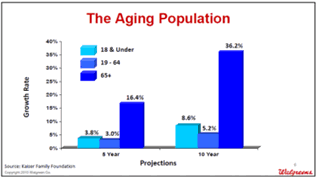
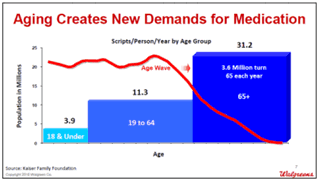
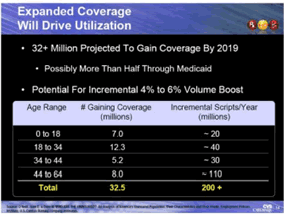
We look at the expansion of Medicare coverage as a free option. If it hits, it could provide a 20% bump to the 636 million scripts CVS dispensed in its drugstores in 2010, and add 35% to CVS’ current earnings. (CVS’ 18% market share x 32 mm people x 2 Rx per person per month x 12 months x $9 incremental after-tax profit per Rx = $0.90 per share.) We don’t know what health care reform will ultimately look like, but we take some comfort in the knowledge that prescription drugs represent just 10% of the total health spend and that increasing patient adherence to drug regimens is among the most cost effective ways to lower medical costs.

The pharmacy companies, particularly the two largest national chains, are well-positioned to benefit from those trends. With half of all Rx dispensed being unplanned, retail pharmacies are a necessity for just-in-time dispensing. Retail pharmacies dispense 81% of all prescriptions – a share that’s been unchanged over four years. Among pharmacy retailers, CVS and Walgreens are the best positioned, with each company operating more than 7,000 stores and ranking either #1 or #2 in 70% of the top 100 markets. CVS fills 18% of the U.S. retail drug market and has a store within three miles of 75% of the population. We expect that CVS and Walgreens will continue to gain share in a growing market, particularly from the smaller independents whose market share has been halved in the past couple of decades to about 20% today. The third significant national chain is Rite-Aid, but the company isn’t much of a threat to the larger rivals because it’s highly leveraged, has a third lower sales per square foot, and fulfills less than half the number of prescriptions dispensed by either CVS drugstores or Walgreens.
There has been some concern that mail order will erode walk-in business. We expect that may have some small impact over time, but over the last four years, mail order’s share of the market has remained at a relatively constant 19%.
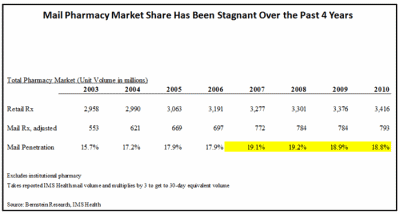
The peak of Big Pharma’s productivity occurred in the mid-90s, and those drugs are now facing the end of their patent lives. Note that the R&D spend is almost 6x what it was in 1990, but the number of approvals is lower. This speaks to the fundamental challenges facing Big Pharma today.
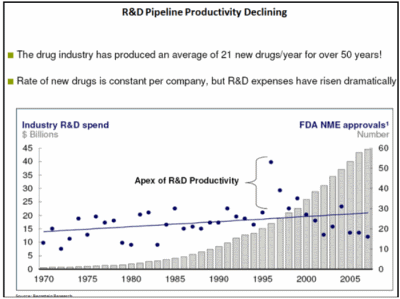
Retail pharmacies will enjoy better margins from the coming generic wave that’s due to peak in 2012, since they make more money selling generic drugs than branded. The margin expansion comes from both having more vendor options and – since they self-distribute – capturing the distributor margin for themselves on every prescription. In the example below, unit gross profit increases at CVS’ pharmacies from $11.50 to $16.00, a 39% increase.
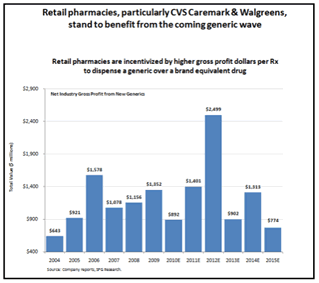
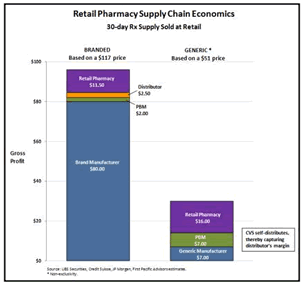
CVS has become a brand unto itself, and with that, private label opportunities will continue to proliferate. Private label products offer CVS a better gross profit opportunity on every sale. At my local supermarket, I buy Thomas’ English Muffins because the private label version lacks the nooks and crannies. In general, I’ve found that consumers are more willing to switch to a private label item if it is something they can’t taste. Medication certainly falls in that category. I now buy the little blue pills that are CVS’ substitute for Aleve, the CVS brand multi-vitamin instead of Centrum, and I find their sunscreen works fine as well. The production issues and recall problems at Johnson & Johnson are adding momentum to the trend. CVS expects its private label business will rise to 20% of overall revenue in the next 2-3 years, up from 17% today. Private label sales hurt comparable store sales because the average price can be 15% to 20% less than for the equivalent branded product, but gross margin can be 10 percentage points higher, increasing the gross profit dollar by about 10%. So we believe the increase in private label over the next two years could increase retail operating income by 3.5%. This still leaves a ton of room for private label expansion. U.S. retailers like Kroger have 28% private brand penetration, which pales next to UK-based Tesco’s 50%. Clearly, this leaves CVS a lot of runway for years to come.
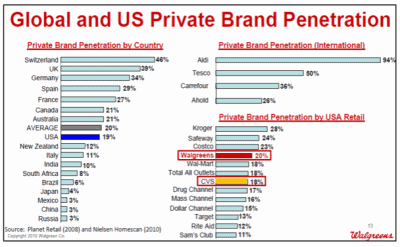
We would be remiss not to talk about Caremark, CVS’ Pharmacy Benefits Manager, since it represents almost half of CVS sales and a bit more than one-third of its profits. For those of you less familiar with the industry, a Pharmacy Benefits Manager, or PBM, is a third-party administrator of prescription drug programs. Among other services, PBMs aggregate the buying power of their many large customers to obtain lower prices from pharmacies and drug manufacturers and induce pharmacists to switch from brands to generics, thereby lowering costs in the supply chain. Caremark fills or manages 20% of all U.S. scripts, serving a network of 64,000 pharmacies and covering 53 million lives. They are the second largest mail order pharmacy after Medco, but they lead the market in Specialty Pharmacy and Generics.
Caremark’s Maintenance Choice program differentiates the company from the competition. With this uniquely integrated model, customers can get mail order pricing and still pick up their prescriptions in a CVS store -- something other PBMs and drugstores don’t offer. It’s a great benefit for people who get caught short of necessary meds because they forgot to refill their 90-day prescription, or because it got lost in the mail. Only 15% of Caremark’s members are on Maintenance Choice today, leaving an addressable opportunity of another 42%.
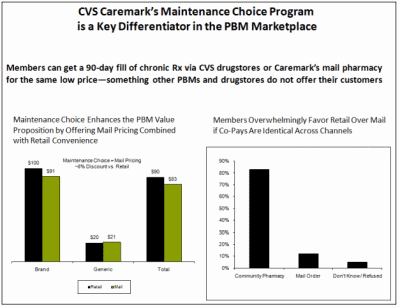
In addition to the opportunities, we see some challenges facing the PBM space, including the possibility of lower future rebates, the introduction by Medicaid of legally mandated transparency of drug acquisition costs, and challenges from traditional health insurers in Specialty Pharma. As a result, we’ve chosen to hedge out a piece of the PBM exposure. With this hedge, we would still benefit if -- as we believe -- Caremark outperforms its rivals over the next few years, and would also be protected if headwinds erode the industry’s profitability.
CVS’ executives have proven themselves to be skilled operators as well as prudent capital allocators. Their attention to the wise use of cash makes sense because they’re invested alongside us. In fact, CVS management has millions of reasons to get it right. Tom Ryan, the retiring CEO, has about $300 million of CVS equity exposure, and three other top executives have a combined exposure of more than $80 million.
By the end of this year, CVS will have returned almost $6 per share in capital to their shareholders over four years, or approximately 18% of their average market capitalization since 2007. If you were to add debt repayment to this, the equity benefit would be 20%. CVS has publicly stated that it intends to spend $3-4 billion per year on share repurchases. Add in the dividend, and you get 7.5-9.5% per year in cash used to enhance shareholder value. Said another way, the cumulative free cash flow over the next five years should exceed 50% of the current market capitalization, and the majority of that will be returned to shareholders.
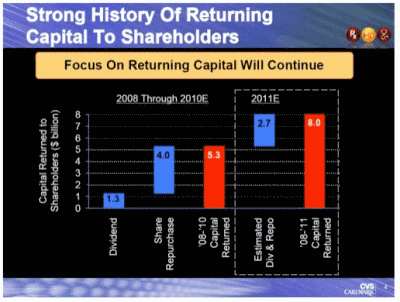
We also think the current valuation ignores what could be significant working capital improvements. CVS grew through acquisition, and it still isn’t where it needs to be. For example, each distribution center (DC) serves only 378 stores compared to the 473 stores that run through the typical Walgreens DC. In 2010, CVS operated with seven inventory management systems, while Caremark had five different claims platforms. By 2013, their goal is to be down to one platform each. The company has said it can reduce retail store inventories by $2 billion over the next three years, representing about a $1.50 per CVS share, or 4.2%. That seems reasonable, since the company’s retail business has 12.8% of its sales tied up in inventory net of payables, compared to Walgreens at just 6.0%. We are not suggesting that CVS is likely to get to the Walgreens’ efficiency anytime soon, but it does lend some comfort to the company’s guidance.
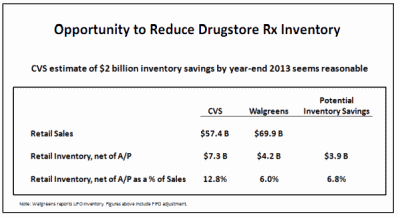
When we first purchased CVS in 2010, it was trading at about 11.5x 2011’s earnings. We felt the valuation adequately compensated for our concerns regarding their PBM business – as well as for our admittedly less robust understanding of its prospects. As CVS’ stock price began to tick up, the PBM comps, Medco and Express Scripts, moved up even more, actually making the CVS stub value less expensive. Using the PBM competition as a comp, we felt that the Caremark value attributable to the total enterprise was about 46%. On that basis, the value of the CVS retail stub traded to just 9.4x free cash earnings. We therefore ended up hedging a portion of the PBM exposure – to capture the lower valuation as well as to eliminate some of the risk and accompanying discomfort of what we don’t know regarding the PBM business. At this point, we still have some PBM exposure, albeit reduced. We believe that Caremark can outperform its peer group as it is now being better managed by Per Lofberg, the former Medco head as its President, and is poised to benefit vis-a-vis their competition. Contributing to this will be their improved customer service, the aforementioned systems improvements, as well as the competitive advantage of their Maintenance Choice integrated model. We wouldn’t characterize CVS as a homerun stock, but it should nevertheless prove to be a solid compounder over the next few years as the macro tailwinds begin to blow and are recognized by other investors.”
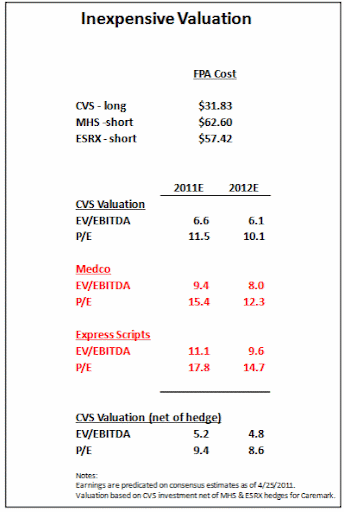
Disclosure: Long CVS.
In addition, FPA Crescent is well known for its shareholder communication. They regularly conduct conference calls to update the fund shareholders on FPA’s view of the world and on the fund’s portfolio activity. These calls have been a rich source of new ideas for me. I first learnt about Ensco through comments made on a call they held post the BP oil spill. The investment has done very well since then.
Two quarters ago, I learnt about CVS Caremark through some comments made by one of their analysts on the call. CVS statistically seemed very cheap then, but I was not very familiar with its business. At the same time, Sequoia fund had exited out of Walgreens because of their lack of confidence in Walgreens’ ability to maintain margins going forward. In order to understand the source of the pharmaceutical drug margins for the suppliers, I spent a good amount of time reading industry reports as well as reading CVS’ and its competitors’ 10-Ks and conference call transcripts. I wrote down everything I learnt into a report. The report turned out to be 40 pages long. Obviously, not everything was relevant to the investment thesis for CVS. But, it was a good way for me to expand my circle of competence into a new industry. Later, I took the report and submitted it as-is for the April Value Contest. I didn’t realize that Gurufocus readers have limited time and only want the relevant information (including me when I am reading other people’s articles). The article got low ratings and probably deservedly so.
However, I urge the reader not to pass on CVS Caremark simply because of the poor quality of my writing. Luckily we a solution on hand to avert this situation. FPA Crescent, on its latest quarterly conference call held on Apr 29, 2011, spent nearly all the time talking about their thesis on CVS Caremark. I am attaching below a transcript of the call along with slides (transcribed by www.advisorperspectives.com)
“Although we have owned CVS since early 2010, we have subsequently purchased additional shares and hedged a portion of their Pharmacy Benefit Management business. Since the nature of the investment changed in both size and structure, we thought further discussion was warranted.
CVS lacks the international component we’ve sought, but we believe the pharmacy companies are well positioned to benefit from a number of macro trends. We prefer investments where the wind is at our backs, and we believe that is the case with this company. The aging population will drive utilization. The population of older people is growing more quickly than younger age groups, and pharmacy visits will therefore increase. What’s more, the 65+ cohort has almost 3x the number of prescriptions filled per year as the 19-64 cohort. In addition, the Medicare market is growing significantly and CVS is well positioned to benefit from an estimated 32 million people expected to gain coverage, beginning in 2014.



We look at the expansion of Medicare coverage as a free option. If it hits, it could provide a 20% bump to the 636 million scripts CVS dispensed in its drugstores in 2010, and add 35% to CVS’ current earnings. (CVS’ 18% market share x 32 mm people x 2 Rx per person per month x 12 months x $9 incremental after-tax profit per Rx = $0.90 per share.) We don’t know what health care reform will ultimately look like, but we take some comfort in the knowledge that prescription drugs represent just 10% of the total health spend and that increasing patient adherence to drug regimens is among the most cost effective ways to lower medical costs.

The pharmacy companies, particularly the two largest national chains, are well-positioned to benefit from those trends. With half of all Rx dispensed being unplanned, retail pharmacies are a necessity for just-in-time dispensing. Retail pharmacies dispense 81% of all prescriptions – a share that’s been unchanged over four years. Among pharmacy retailers, CVS and Walgreens are the best positioned, with each company operating more than 7,000 stores and ranking either #1 or #2 in 70% of the top 100 markets. CVS fills 18% of the U.S. retail drug market and has a store within three miles of 75% of the population. We expect that CVS and Walgreens will continue to gain share in a growing market, particularly from the smaller independents whose market share has been halved in the past couple of decades to about 20% today. The third significant national chain is Rite-Aid, but the company isn’t much of a threat to the larger rivals because it’s highly leveraged, has a third lower sales per square foot, and fulfills less than half the number of prescriptions dispensed by either CVS drugstores or Walgreens.
There has been some concern that mail order will erode walk-in business. We expect that may have some small impact over time, but over the last four years, mail order’s share of the market has remained at a relatively constant 19%.

The peak of Big Pharma’s productivity occurred in the mid-90s, and those drugs are now facing the end of their patent lives. Note that the R&D spend is almost 6x what it was in 1990, but the number of approvals is lower. This speaks to the fundamental challenges facing Big Pharma today.

Retail pharmacies will enjoy better margins from the coming generic wave that’s due to peak in 2012, since they make more money selling generic drugs than branded. The margin expansion comes from both having more vendor options and – since they self-distribute – capturing the distributor margin for themselves on every prescription. In the example below, unit gross profit increases at CVS’ pharmacies from $11.50 to $16.00, a 39% increase.


CVS has become a brand unto itself, and with that, private label opportunities will continue to proliferate. Private label products offer CVS a better gross profit opportunity on every sale. At my local supermarket, I buy Thomas’ English Muffins because the private label version lacks the nooks and crannies. In general, I’ve found that consumers are more willing to switch to a private label item if it is something they can’t taste. Medication certainly falls in that category. I now buy the little blue pills that are CVS’ substitute for Aleve, the CVS brand multi-vitamin instead of Centrum, and I find their sunscreen works fine as well. The production issues and recall problems at Johnson & Johnson are adding momentum to the trend. CVS expects its private label business will rise to 20% of overall revenue in the next 2-3 years, up from 17% today. Private label sales hurt comparable store sales because the average price can be 15% to 20% less than for the equivalent branded product, but gross margin can be 10 percentage points higher, increasing the gross profit dollar by about 10%. So we believe the increase in private label over the next two years could increase retail operating income by 3.5%. This still leaves a ton of room for private label expansion. U.S. retailers like Kroger have 28% private brand penetration, which pales next to UK-based Tesco’s 50%. Clearly, this leaves CVS a lot of runway for years to come.

We would be remiss not to talk about Caremark, CVS’ Pharmacy Benefits Manager, since it represents almost half of CVS sales and a bit more than one-third of its profits. For those of you less familiar with the industry, a Pharmacy Benefits Manager, or PBM, is a third-party administrator of prescription drug programs. Among other services, PBMs aggregate the buying power of their many large customers to obtain lower prices from pharmacies and drug manufacturers and induce pharmacists to switch from brands to generics, thereby lowering costs in the supply chain. Caremark fills or manages 20% of all U.S. scripts, serving a network of 64,000 pharmacies and covering 53 million lives. They are the second largest mail order pharmacy after Medco, but they lead the market in Specialty Pharmacy and Generics.
Caremark’s Maintenance Choice program differentiates the company from the competition. With this uniquely integrated model, customers can get mail order pricing and still pick up their prescriptions in a CVS store -- something other PBMs and drugstores don’t offer. It’s a great benefit for people who get caught short of necessary meds because they forgot to refill their 90-day prescription, or because it got lost in the mail. Only 15% of Caremark’s members are on Maintenance Choice today, leaving an addressable opportunity of another 42%.

In addition to the opportunities, we see some challenges facing the PBM space, including the possibility of lower future rebates, the introduction by Medicaid of legally mandated transparency of drug acquisition costs, and challenges from traditional health insurers in Specialty Pharma. As a result, we’ve chosen to hedge out a piece of the PBM exposure. With this hedge, we would still benefit if -- as we believe -- Caremark outperforms its rivals over the next few years, and would also be protected if headwinds erode the industry’s profitability.
CVS’ executives have proven themselves to be skilled operators as well as prudent capital allocators. Their attention to the wise use of cash makes sense because they’re invested alongside us. In fact, CVS management has millions of reasons to get it right. Tom Ryan, the retiring CEO, has about $300 million of CVS equity exposure, and three other top executives have a combined exposure of more than $80 million.
By the end of this year, CVS will have returned almost $6 per share in capital to their shareholders over four years, or approximately 18% of their average market capitalization since 2007. If you were to add debt repayment to this, the equity benefit would be 20%. CVS has publicly stated that it intends to spend $3-4 billion per year on share repurchases. Add in the dividend, and you get 7.5-9.5% per year in cash used to enhance shareholder value. Said another way, the cumulative free cash flow over the next five years should exceed 50% of the current market capitalization, and the majority of that will be returned to shareholders.

We also think the current valuation ignores what could be significant working capital improvements. CVS grew through acquisition, and it still isn’t where it needs to be. For example, each distribution center (DC) serves only 378 stores compared to the 473 stores that run through the typical Walgreens DC. In 2010, CVS operated with seven inventory management systems, while Caremark had five different claims platforms. By 2013, their goal is to be down to one platform each. The company has said it can reduce retail store inventories by $2 billion over the next three years, representing about a $1.50 per CVS share, or 4.2%. That seems reasonable, since the company’s retail business has 12.8% of its sales tied up in inventory net of payables, compared to Walgreens at just 6.0%. We are not suggesting that CVS is likely to get to the Walgreens’ efficiency anytime soon, but it does lend some comfort to the company’s guidance.

When we first purchased CVS in 2010, it was trading at about 11.5x 2011’s earnings. We felt the valuation adequately compensated for our concerns regarding their PBM business – as well as for our admittedly less robust understanding of its prospects. As CVS’ stock price began to tick up, the PBM comps, Medco and Express Scripts, moved up even more, actually making the CVS stub value less expensive. Using the PBM competition as a comp, we felt that the Caremark value attributable to the total enterprise was about 46%. On that basis, the value of the CVS retail stub traded to just 9.4x free cash earnings. We therefore ended up hedging a portion of the PBM exposure – to capture the lower valuation as well as to eliminate some of the risk and accompanying discomfort of what we don’t know regarding the PBM business. At this point, we still have some PBM exposure, albeit reduced. We believe that Caremark can outperform its peer group as it is now being better managed by Per Lofberg, the former Medco head as its President, and is poised to benefit vis-a-vis their competition. Contributing to this will be their improved customer service, the aforementioned systems improvements, as well as the competitive advantage of their Maintenance Choice integrated model. We wouldn’t characterize CVS as a homerun stock, but it should nevertheless prove to be a solid compounder over the next few years as the macro tailwinds begin to blow and are recognized by other investors.”

Disclosure: Long CVS.